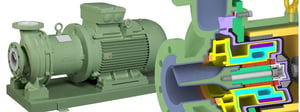
How does a magnetic drive pump work?
Magnetically driven pumps are the industry standard when processing harsh and highly corrosive applications.
So, how does a magnetic drive pump work? The centrifugal force driven by two rotating magnets rather than being directly coupled to a motor. This eliminates the need for a mechanical seal, therefore making magnetic drive pumps seal less and leak proof.
The traditional method of using a mechanical seal means that a film of liquid covers the seal faces. This then has a greater chance of liquid leakage.
A magnetically driven pump is totally enclosed, and therefore does not have this risk of leakage. The pump operates just like any other centrifugal pump. Fluid enters through the inlet of the pump and into the eye of the impeller.
As the impeller rotates, the liquid accelerates between the vanes, gaining velocity and pressure until it exits at the outside diameter and directed to the pump outlet by the volute casing.
The impeller connects to the inner magnet and rotates around a shaft. The inner magnet sits within the rear casing sealed to the front casing.
Sat outside of the rear casing is the drive magnet which is then coupled to the electric motor. As the motor and therefore also the drive magnet rotates, the inner magnet also turns the impeller in line with the rotation of the drive magnet.
The centrifugal force then allows the pump to operate without any risk of liquid leakage to the external atmosphere.
If you have a particular enquiry, please email us.
Find us on Socials
We regularly update our LinkedIn page with articles and news, so go give us a follow to stay up to date.






